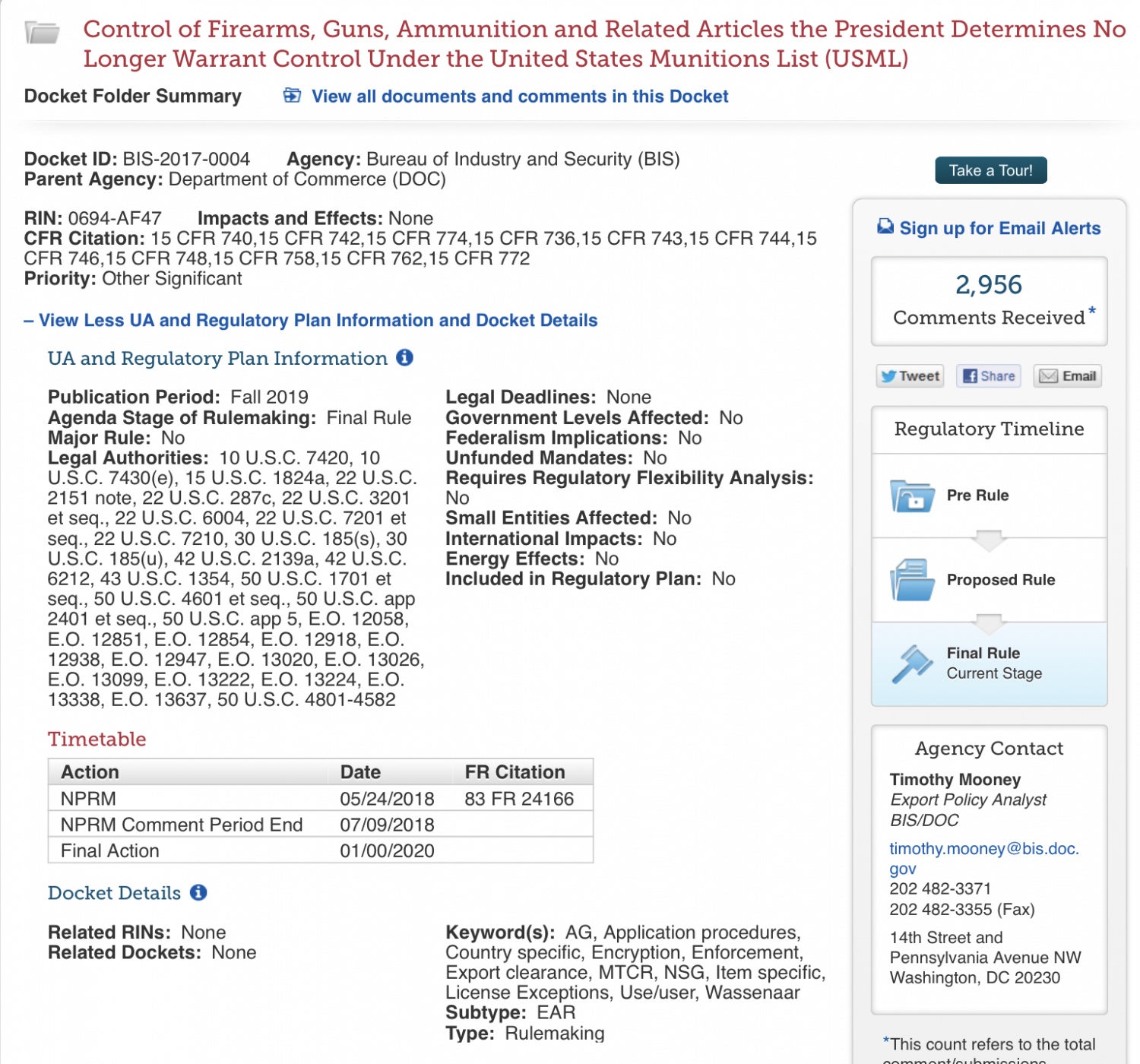About a year ago we reported on the possibility of easing the burden on Federal Firearms License (FFL) holders in terms of the International Trafficking of Arms (ITAR) regulatory requirements. ITAR for FFLs is inherently confusing: while dealers usually aren’t required to obtain an ITAR license, manufacturers can be subject to the regulations, even if they have no plans to export any products. For a small FFL manufacturer who mainly engages in gunsmithing or builds a few guns, a $3,000 fee for not exporting a single item can cut into their bottom line.
After months of comments and delays, it appears that certain firearms, guns, ammunition and accessories will move from the Department of State United States Munitions List (USML) to the Department of Commerce, Bureau of Industry and Security, Export Administration Regulations (EAR). It will take some time to read through the final rule (which has yet to be entered into the Federal Register) and determine the actual changes for FFLs. But moving (some) firearms from the USML/DOD/ITAR is a really good sign that a regulatory burden for FFLs has been lifted.
ITAR For FFLs – End Of USML Control For Certain Firearms, Guns, Ammo

ITAR For FFLs – End Of USML Control For Certain Firearms, Guns, Ammo
Control of Firearms, Guns, Ammunition and Related Articles the President Determines No Longer Warrant Control Under the United States Munitions List (USML)
https://www.regulations.gov/docket?D=BIS-2017-0004
This proposed rule describes how articles the President determines no longer warrant control under United States Munitions List (USML) Category I—Firearms, Close Assault Weapons and Combat Shotguns; Category II—Guns and Armament; and Category III—Ammunition/Ordnance would be controlled under the Commerce Control List (CCL). This proposed rule is being published simultaneously with a proposed rule by the Department of State that would revise Categories I, II, and III of the USML to describe more precisely the articles warranting continued control on that list.
The changes described in this proposed rule and in the State Department’s companion proposed rule on Categories I, II, and III of the USML are based on a review of those categories by the Department of Defense, which worked with the Departments of State and Commerce in preparing the amendments. The review was focused on identifying the types of articles that are now controlled on the USML that are either (i) inherently military and otherwise warrant control on the USML or (ii) if of a type common to non-military firearms applications, possess parameters or characteristics that provide a critical military or intelligence advantage to the United States, and are almost exclusively available from the United States. If an article satisfies one or both of those criteria, the article remains on the USML. If an article does not satisfy either criterion, it has been identified in the new Export Control Classification Numbers (ECCNs) included in this proposed rule. Thus, the scope of the items described in this proposed rule is essentially commercial items widely available in retail outlets and less sensitive military items.
BIS has created ECCNs, referred to as the “600 series,” to control items that would be removed from the USML and controlled under the CCL, or items from the Wassenaar Arrangement on Export Controls for Conventional Arms and Dual Use Goods and Technologies Munitions List (Wassenaar Arrangement Munitions List or WAML) that are already controlled elsewhere on the CCL.
###
BIS believes the control of these firearms under the EAR is justified because the firearms described in this proposed rule are either not inherently military or do not warrant the obligations that are imposed under the ITAR pertaining to such items. After review, the Defense Department, in conjunction with the Departments of State and Commerce, concluded that the firearms in this proposed rule also do not provide a critical military or intelligence advantage to the United States, are not the types of weapons that are almost exclusively available from the United States, and are manufactured from “technology” that is widely available. Moreover, the firearms have commercial and other non-military characteristics that distinguish them from other articles controlled under the ITAR. There is a significant worldwide market for firearms in connection with civil and recreational activities such as hunting, marksmanship, competitive shooting, and other non-military activities. Because of the popularity of shooting sports in the United States, for example, many large chain retailers carry a wide inventory of the firearms described in the new ECCNs for sale to the general public. Firearms available through U.S. retail outlets include rim fire rifles, pistols, modern sporting rifles, shotguns, and large caliber bolt action rifles, as well as their “parts,” “components,” “accessories” and “attachments.”
(continued here regulations.gov)
 Your Privacy Choices
Your Privacy Choices
